Field Observation Report, 20-21 April 2019 at Lakhwar Multipurpose Dam Project, Lohari and Vyasi Hydro Electric Project, Juddo. This author, also an applicant in NGT petition, visited the Lakhwar and Vyasi project area before the sub committee of MoEF’s Expert Appraisal Committee (EAC) for River Valley Projects visited the site on Apr 22, 2019.
The proposed site of Multipurpose Lakhwar dam project was seen affected with multiple landslides. One such fresh landslide was seen right at the site where the 204 meter high dam is supposed to be built. Locals revealed that many of the landslides in and around the location have become perennial.
The interactive map of the area shows the pics of places and ongoing issues associated with the proposed Lakhwar dam and under construction Vyasi HEP. For detailed description and pics of places marked viewers can open the map in separate window by clicking on the square on the top right side.
There are two roads running along the left and right bank of Yamuna river to access the dam site. While about 1 km stretch of access road built for the Lakhwar Project along the left bank of the river has been completely washed away during 2010 and 2013 floods, the access road along the right bank of Yamuna river (branching off from NH 123) was full with pits and loose gravels lying all over it.

Local found it very difficult to walk or drive over. However, prior to EAC visit, the road was repaired. In this context, all the works done for the Lakhwar project also needs independent scrutiny.
The floods have also damaged the protection wall on the right side of the rope way bridge near project site and on the left side about 100 metres downstream the ropeway bridge.
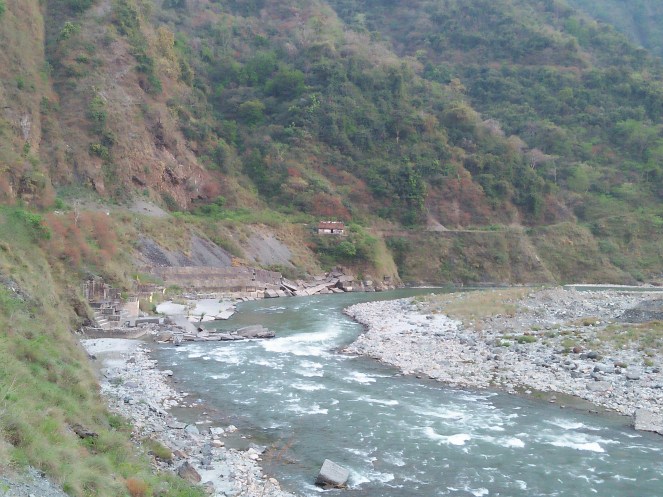
Kona, the first village which is in full submergence area is located about 1 km upstream of dam site on the left bank of the river. There are about 10 families of which 4 have migrated to other locations. The 6 families living in the village reported of facing great difficulties as they have been deprived of basic developmental work like water, power, roads for about past 30 years under the pretext of proposed dam and consequent submergence. Villagers are forced to climb up 2 km uphill to access the transport facilities to nearby market.

All the villages that have suffered by the stoppage of development work for three decades should be compensated for this suffering. Their lands should be given back to them and they should be given fresh rehabilitation package as per current practices and the land be taken from them a year before submergence if the project goes ahead after necessary appraisal and scrutiny.
A stream on the right side of the village namely Kuna Khala which immediately joins Yamuna river was full of rubble. Villagers said that few years back there was cloud burst like heavy rain causing flash flood in the Nala. After the incident villagers reported of reduced flow in the stream.
In all there were at least 8 landslide locations along about 3 km river length upstream of dam site including 5 on the right bank and 3 on the left bank including Kuna Khala rubble. Villagers said that the mountains are weak and prone to perennial sliding once the upper vegetative cover is gone due to man-made or natural factors.
The most surprising thing learnt during the visit was that the muck generated during previously done construction work for Lakhwar project in 1990s was dumped upstream of the dam location. At that time villagers had questioned the wisdom of developer as the muck would come down with flood impacting the dam reservoir and river in downstream areas.
Locals said that some Tripathi contractor in those days had first agreed with the villagers but later on defended the act and continued muck dumping upstream the dam site. The muck dumping also affected about 125 Nalis of fertile farming land of villagers. Over the years, the dump has been falling apart and getting eroded into the river during high flows thus causing further problems in the area. Villagers fill that it would adversely impact the Vyasi reservoir in coming days which is being built about 5 km downstream the proposed Lakhwar dam site.
Another peculiar incident happening about 3 km downstream the Lakhwar site is running of two ‘illegal’ stone crushers on the right bank of the river. As per sources the stone crushers were being run by Gammon India, the developer of the Vyasi HEP. It is also revealed that their license expired some three years back. Moreover the stone crusher were seen doing in-stream and deep quarrying of riverbed against the norms.



The crushers are supposed to install sedimentation tanks but none was there and silt laden water after washing of crushed minerals was being discharged directly into the Yamuna river.
At Vyasi HEP dam site at Juddo muck was seen reaching the active current of the river. Polluted water from concrete mixture plant was also being dumped into the river.

There is a huge heap of fine silt taken out from the dam intake channel and tunnel loosely dumped by the river. The silt will certainly be washed out in the river during coming monsoon season.

There is a huge heap of fine silt taken out from the dam intake channel and tunnel loosely dumped by the river. The silt will certainly be washed out in the river during coming monsoon season.
The situation of muck dumping is worse at Hathiyari which is power station site of Vyasi HEP located some 7 km downstream from the dam site. Huge amount of muck is being dumped at two places. Both the locations are adjoining to River Yamuna.
First site has made steep fall from where entire muck is reaching into river Yamuna. At second site muck has been over spilling in the river for past many years.
Locals say whenever there is increased flow in the river due to rain or flood, most of the muck get washed away in the river. Villagers also fear a repeat of June 2013 like flood disaster that struck Srinagar town in Pouri due to illegal muck dumping by Alaknanda HEP. MoEF and EAC had turned a blind eye to illegalities then too.
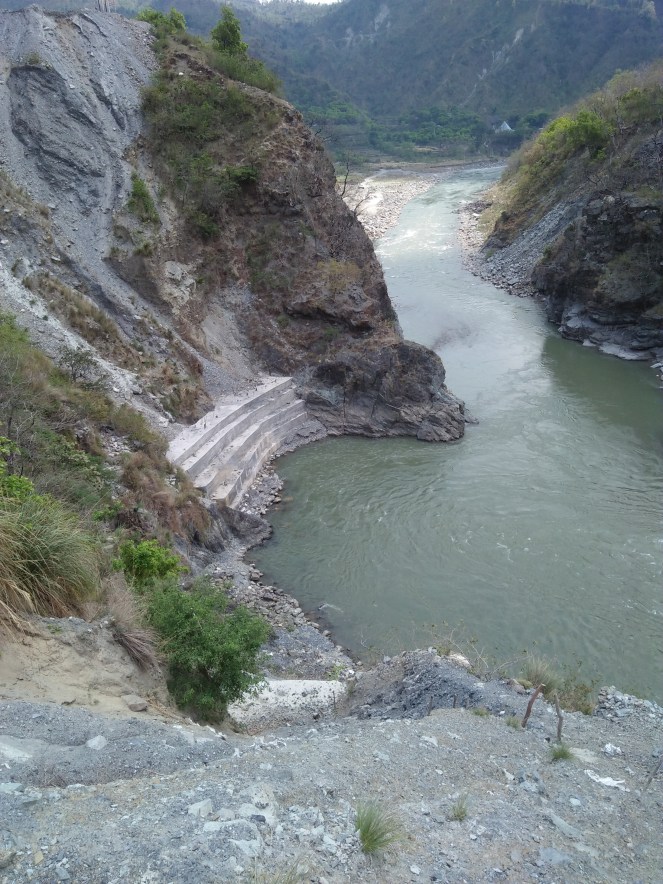
Villagers have been raising voice against the act but not much has changed. They say for past six months the board describing capacity and amount of muck dumped at the sites have not been changed. However prior to EAC visit, the top of muck site which was of conical shape was flattened.

Similarly, the wire crating and protection wall work done between 19 to 21 April 2019 has ultimately encroached upon an active curve of River Yamuna. The act not only has changed river channel by training it but also has shrunk the active part of river channel.
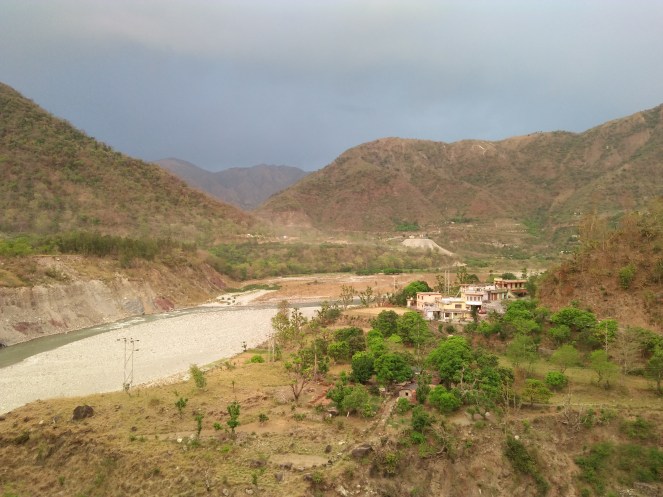
At the location the narrow Yamuna valley opens up to wider plains, as a result high speed wind current keep sweeping at Hathiyari and Kata Pathar. As a result the loose muck gets blown around the area. As per villagers what was some time earlier clear atmosphere has turned dusty and hazy impacting their vision and health. They further revealed that the act has also affected the growth of fodder vegetation and crops in villages close to the muck dumping site.
Very credible sources have also raised doubt over quality of construction work now ongoing at Vyasi HEP especially regarding stabilization of slope. It has also come to light that the earth quake measuring instruments are now being installed at the Vyasi HEP site which the developer should have installed about five years ago.
A new power station wall for Vyasi HEP is being built, which totally falls inside the active stream of river Yamuna thus further narrowing down the river space.
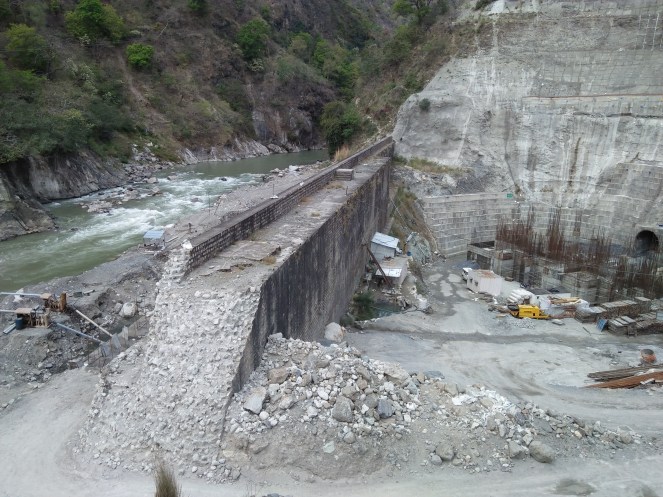
There are many small and big landslide taking place around the Vyasi power station site apart from continuous bank erosion near Bosan along right bank and Kata Pathar village along left bank of river Yamuna.
The continuous muck dumping at dam and power station site of Vyasi HEP and discharge of silt laden water by Gammon India stone crushers have severely affected the water quality of Yamuna river taking its toll on aquatic life. The act has also been impacting the capacity of Dak Pathar barrage and Asan barrage fed by Shakti Canal of Yamuna river emanating from Dak Pathar barrage.

Sources also said that the riverbed quarrying by stone crushers installed at Nainbagh, Naugaon and Badkot and dumping of debris by Char Dham Highway project road widening work is only adding into the aggravating situation.

Conclusion All these ongoing illegalities were being attempted to be window dressed for the EAC on April 20-21, as SANDRP representative saw on ground. We hope the EAC members will see through these attempts and understand the enormity of violations happening at Vyasi Dam site and also the serious risks of taking up the biggest project of Yamuna River Basin at this fragile location, that too by a developer that has already proved its poor track record in ongoing.
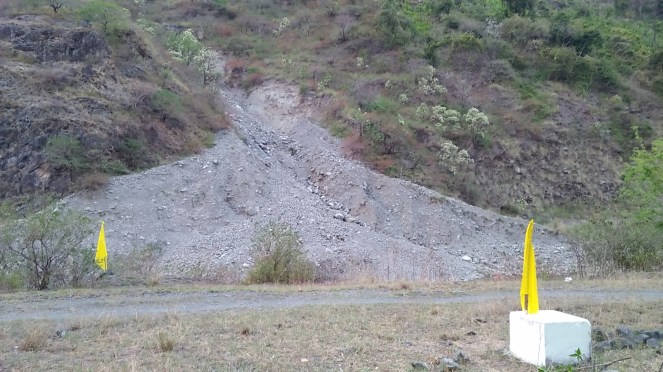
All this also underlines the need for complete fresh impact assessment of the Lakhwar project starting from scoping stage and following the EIA notification of 2006, the small amount of work that has happened about three decades ago cannot be an excuse for not doing that. Our letter to EAC in this regard can be seen in the annexure below.
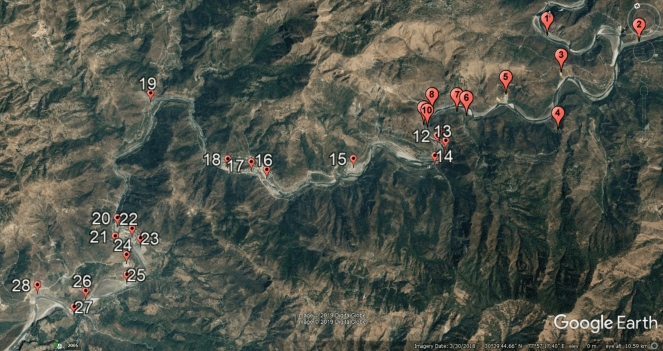
(Places numbered in the feature image 1. Yamuna River, 2. Aglar River, 3. -6., 8., 14. 19., 21. Landslide Sites, 7. &10. Muck dumped by Lakhwar construction work, 9. Lakhwar Dam site, 11., Washed out Lakhwar project road, 12. Riverbed Mining, 13. Damaged Flood Protection blocks, 15., Illegal Stone Crushers, deep riverbed mining and discharge of polluted water by Gemon India, 16. Vyasi HEP site, 17., Gemon India Mixture Plant, 18. Muck dumped by Vyasi HEP, 20., Vyasi HEP Power Station, 22.-23. Muck dumped at Vyasi HEP site reaching the river, 24. Stone Crusher Site, 25. Riverbed Mining, 26.-28 Riverbank Erosion.)
Moreover, having seen the violations happening at the Vyasi project and on the Yamuna river bed and flood plain, we hope the EAC will take necessary action against the project developer for these violations. We would again underline that on MoEF’s website, we could see no monitoring or site visit reports for Vyasi project for which clearance was given 12 years ago, which is total violation of EIA notification, as we wrote to you two days ago. We look forward to seeing EAC’s action in this regard.
Bhim Singh Rawat, SANDRP (bhim.sandrp@gmail.com)
We are thankful to Siddharth Agarwal of VEDITUM for helping us prepare the interactive map.
Annexure 1.
April 18, 2019
To
Chairman and Members
Expert Appraisal Committee for River Valley Projects
MoEF, New Delhi 110 003
Sub: UGENT: Appraisal of Lakhwar Project on Yamuna River in Uttarakhand
Respected Chairman and Members,
We have just seen from the agenda of the EAC for RVP meeting to be held on April 23, 2019 that one of the projects to be considered is the Lakhwar Project, as per the directions of honorable National Green Tribunal. In this context we would like to bring to your attention following points.
- The operative part of the NGT directions dated January 10, 2019 in Application No 431 of 2015 to EAC reads: “9. After considering the pleadings and materials on record, we are of the considered opinion that the clarifications given by the Project Proponent, the report of the expert Committee and finding of various studies need to be looked into and studied by the EAC and project needs to be reappraised in terms of EIA notification, 2006.
- We, therefore, direct the EAC to appraise the project afresh in terms of EIA notification 2006 and impose additional general and specific conditions as may be considered necessary. EAC will be free to call for any reports which it may consider necessary.”
- So the honorable NGT has asked EAC that “project needs to be reappraised in terms of EIA notification, 2006.” This would entail that the project be appraised for scoping stage clearance, followed by getting the EIA done as required under EIA notification 2006, followed by public hearings and consultations, followed by appraisal and decision by MoEF to consider for clearance. None of these has happened for the Lakhwar Project, and we hope the EAC will ask the project developer to apply for scoping clearance and follow the process therefrom as per the EIA notification 2006.
- This would also be consistent with what EAC did in case of the 120 MW Vyasi HEP, which was part of the Lakhwar Vyasi project for which some preliminary work happened in 1980s and no work has happened for the last 27 years. The Vyasi project went through the full clearance process as required under EIA notification and hence Lakhwar should also be going through the same process.
- In fact the EAC had noted in its minutes of meeting on 12.11.2010 when Lakhwar project was discussed and as quoted in the NGT order of Jan 10 2019, “The EIA/ EMP reports prepared do not serve much purpose in the absence of an approved Form-1 and TOR.” Indeed, just existence of a document titled EIA/ EMP of Lakhwar Dam is not good enough reason for the project to go ahead, if it has not gone through the process as required under EIA notification 2006 as required by NGT. Hence it is in the best interest of the project and statutory requirements that project apply for scoping clearance.
- In fact a large number of people from Civil Society groups and experts had written collectively in April 2013, why the Lakhwar project as planned currently should not go forward, which can be seen here: https://sandrp.in/2013/04/22/lakhwar-dam-project-why-the-project-should-not-go-ahead/. This provides details about various aspects of the project and we hope you will take these aspects into account without any prejudice, with an open mind, while considering the project.
- Another more recent article shows google images of how the area next to the river near the Lakhwar Dam site is getting destroyed by the crusher units and dumping of waste, see: https://sandrp.in/2019/04/11/yamuna-jayanti-2019-will-the-agony-of-the-river-people-speak-in-elections/. We request you to kindly ask MoEF to take urgent action to stop this destruction of Yamuna river and its flood plain. It also shows google images from close to Vyasi dam, again showing destruction and violation, requiring urgent action from MoEF. The three google images mentioned here are attached with necessary captions.
- MoEF orders also require that there should be cumulative impact assessment and carrying capacity study of the Yamuna basin before this additional massive intervention is taken up in this basin. Such a study should not be a state specific study as has been the practice but has to be a basin wide study, including all the states in the basin. This study should be done by an agency that has no conflict of interest in any manner.
- The June 2013 Uttarakhand flood disaster also had impact in this Yamuna basin, and the Supreme Court appointed Ravi Chopra committee had also noted this as the NGT order of Jan 10, 2019 has taken note of. In this context, it become all the move imperative that a disaster potential assessment of major intervention like the Lakhwar dam be done, as part of of the proposed EIA of the project before project can be considered for clearance.
- One of the key objectives of the government, Supreme Court, High Courts and NGT today is to rejuvenated National River Ganga. The Lakhwar project, a major intervention, is also in the same Ganga River Basin. Hence before taking any decision about the project, impact of the project on the Ganga rejuvenation objection also needs to be kept in mind.
We hope you will consider all these points while appraising Lakhwar Project. We would like to add that one of us is also an applicant before the NGT in Lakhwar petition. Thanking you,
Yours sincerely,
Bhim Singh Rawat (bhim.sandrp@gmail.com)
Himanshu Thakkar (ht.sandrp@gmail.com)
South Asia Network on Dams, Rivers & People
50-D, AD block, Shalimar Bagh,
Delhi 110 088. (https://sandrp.in/)
ENDORSED BY:
Annexure 2& 3. Local media reports on EAC visit.
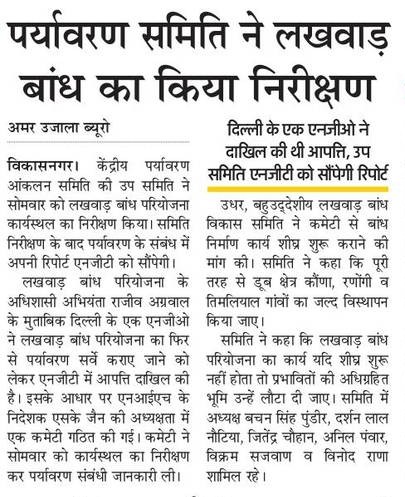


One thought on “Lakhwar & Vyasi Dam: Different reality before the window dressing for EAC”